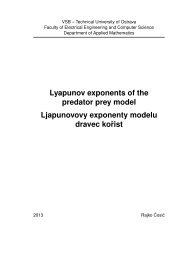The Boundary Element Method for the Helmholtz Equation ... - FEI VÅ B
The Boundary Element Method for the Helmholtz Equation ... - FEI VÅ B
The Boundary Element Method for the Helmholtz Equation ... - FEI VÅ B
You also want an ePaper? Increase the reach of your titles
YUMPU automatically turns print PDFs into web optimized ePapers that Google loves.
17<strong>the</strong> boundary value problem (see, e.g., [6], [9])⎧∆u + κ 2 u = 0 in Ω ext ,⎪⎨⎪⎩x ∇u s (x),∥x∥u s + u i = u in Ω ext ,− iκu s (x)u = 0 on Γ D ,∂u∂n = 0 on Γ N, 1 = O ∥x∥ 2<strong>for</strong> ∥x∥ → ∞(2.4)with u := u s + u i denoting <strong>the</strong> total wave. <strong>The</strong> homogeneous Dirichlet and Neumannboundary conditions represent <strong>the</strong> so-called sound-soft and sound-hard scattering, respectively.Assuming that <strong>the</strong> source of <strong>the</strong> incident wave is remote enough, we can approximateu i by plane waves, i.e.,u i (x) := e iκ⟨x,d⟩with d denoting <strong>the</strong> normalized propagation direction. Because such u i satisfies <strong>the</strong> Helmhholtzequation, we can reduce <strong>the</strong> problem (2.4) to⎧⎪⎨⎪⎩ ∇u s (x),x∥x∥∆u s + κ 2 u s = 0 in Ω ext ,u s = −u i on Γ D ,∂u s∂n = −iκ⟨d, n⟩u i on Γ N , − iκu s (x)1 = O ∥x∥ 2 <strong>for</strong> ∥x∥ → ∞with n denoting <strong>the</strong> unit outward normal vector to ∂Ω. <strong>The</strong> total wave is <strong>the</strong>n given by<strong>the</strong> <strong>for</strong>mula u = u s + u i .2.2 Fundamental Solution<strong>The</strong> knowledge of <strong>the</strong> fundamental solution is essential <strong>for</strong> <strong>the</strong> derivation of <strong>the</strong> representation<strong>for</strong>mulae and <strong>the</strong> corresponding boundary integral equations. <strong>The</strong> fundamentalsolution <strong>for</strong> <strong>the</strong> <strong>Helmholtz</strong> equation in R 3 is introduced by <strong>the</strong> following definition.Definition 2.1 (Fundamental Solution). <strong>The</strong> function v : R 3 × R 3 → C defined asv κ (x, y) := 1 e iκ∥x−y∥4π ∥x − y∥is called <strong>the</strong> fundamental solution <strong>for</strong> <strong>the</strong> <strong>Helmholtz</strong> equation in R 3 .In <strong>the</strong> following <strong>the</strong>orems we provide some properties of <strong>the</strong> fundamental solution v κ ,which will be used <strong>for</strong> <strong>the</strong> derivation of <strong>the</strong> representation <strong>for</strong>mulae.









